What Selling B2B To Millions Teaches You About Email Marketing
-
UncategorizedUpdatedPosted:
On this page
- Selling B2B SaaS or physical products at scale is no different to selling B2C products.
- If you have a B2C product then you should consider a B2B product as a growth offering – lifecycle email can help you maximize your conversions here.
- Treating your customers as individuals and acknowleding their use-cases is the most effective thing you can do. Use data-driven segments!
The internet has changed the way software is sold. Now businesses can sell to tens or hundreds of thousands, if not millions, of people with a small team and a scalable infrastructure. This has blurred the lines between B2C products and B2B products.
Companies like Github, Atlassian, SlideShare, Apple and 37Signals and others have many individual or small-time customers and leverage these to sell expensive, valuable products to larger customers – they all make a lot of money doing so. Similarly, companies like Yammer and LinkedIn take social or consumer-driven ideas into the business space.
The four tactics below catalog email marketing campaigns that B2B online businesses use to drive conversions.
1. Organisations are an advertising channel
Organisations are essentially giant networks. People are constantly communicating: sitting in open-plan offices, sending each other emails, chatting over lunch, going to meetings. These are opportunities for true word-of-mouth.
If you’re selling business software into organizations with more than just a handful of employees then you should consider building out funnels that encourage the sharing of your product within the organization.
For example, Mixpanel offer all of their customers, no matter what plan they’re on, the ability to invite colleagues to their application at any time:
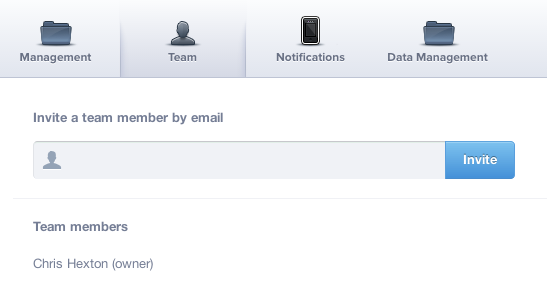
At first it may seem a little strange: team member management is often reserved for enterprise customers. In this case though, it is a great strategy. Mixpanel has many large customers and the more individuals that interact with Mixpanel’s software, the better. Earlier this year we blogged about the amazing success of a campaign that specifically encouraged inter-office sharing run by Userlicious. The results of that campaign were a lift in revenues of 35%.
The marginal cost of supporting multiple logins means that any incremental revenue that comes via this channel is virtually pure profit – the acquisition costs are nearly zero. How many Mixpanel users have partners, friends or family that could benefit from Mixpanel? How many work with other companies that could benefit from Mixpanel?
Yammer provide another great example of a B2B product that utilises inter-office sharing for growth. Someone in the organization has to sign up to Yammer. After confirming their account the first thing they see is an option to ‘invite others to their Yammer network’.
This sort of virality is important as a growth channel. Here’s the Yammer flow in pictures:
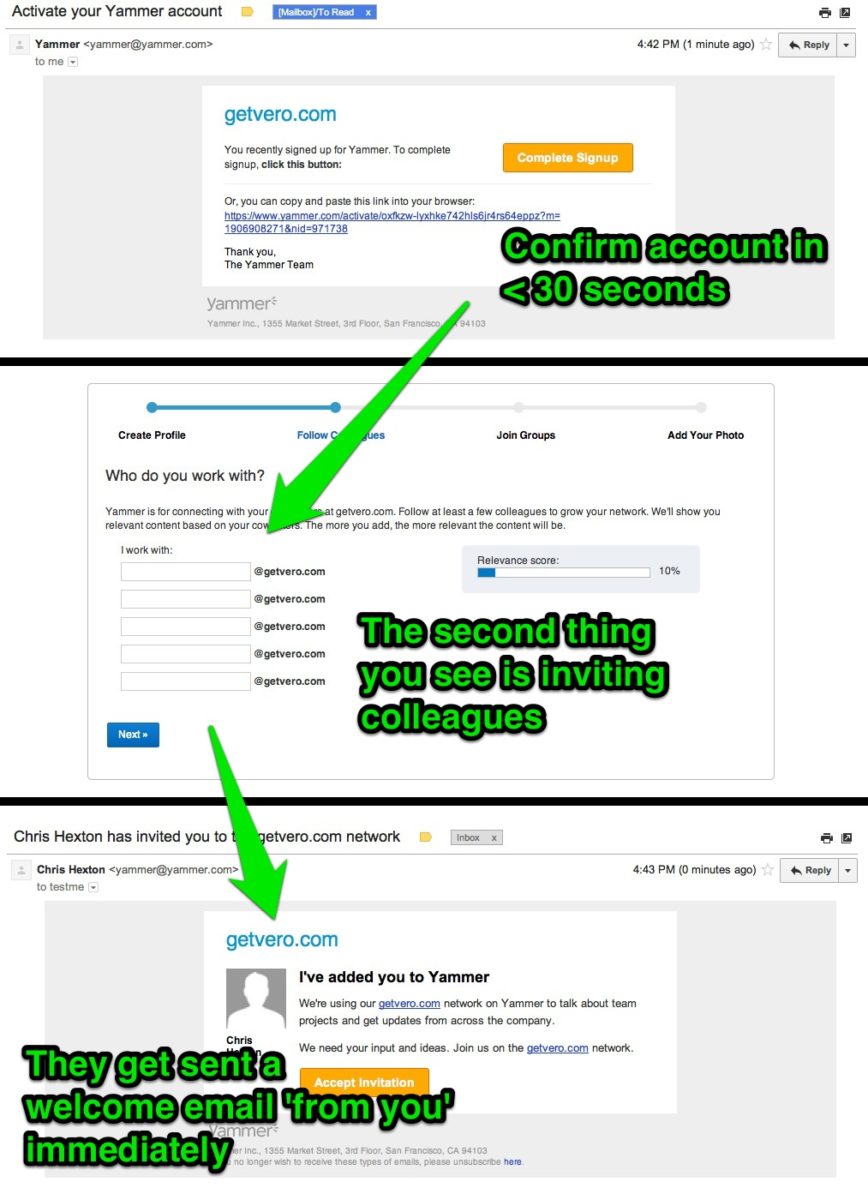
Yammer’s use of email to complete the signup flow and encourage rapid adoption of the platform within a new organization is a great example of how important it is to consider all channels for marketing your products.
Think about how you can encourage your business customers to ‘share’ your product with their colleagues whilst providing value at the same time.
2. Speak their language and treat business customers as special
Selling hundreds of millions of devices a year, Apple has massive reach – both with consumer and business customers.
Whilst Microsoft reigned as the business platform of choice for decades, Apple now accounts for 90% of all business tablet activations and 72% of all mobile device activations. They have a lot of experience selling into businesses and know an insane amount about their customers. Ever been into an Apple store and swiped your card? They know what you’ve bought before – it’s on the screen in front of them!
When it comes to email marketing, Apple are good at two things:
- Cross-selling business products to non-business customers.
- Selling more business products to existing business customers
Dialling in on the second point, Apple creates segments based on past purchase history and browsing habits. This reduces the pool of recipients for each of it’s email campaigns to a targeted selection that is more likely to convert. Since they know exactlyw hat you’ve bought in the past they’re very good at getting business customers to buy again and again. Take this newsletter introducing new Macs to business customers:

Similarly these ads for iPads and iPhones as work devices directly target business customers. It is segmentation and strategy like this that has pushed Apple further-and-further into small, medium and large businesses – overtaking Blackberry and Microsoft in the minds of most:

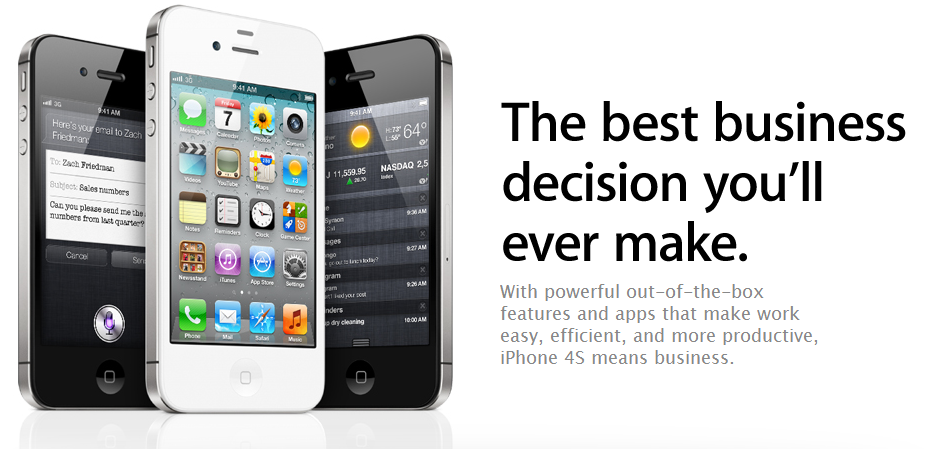
This examples employ the perfect sort of segmentation to get current business customers that looking to enhance their offering to purchase again.
By tracking past purchases or purchase intent you too can increase the ROI on each campaign you send. A few simple ideas you could try include targeting “Loyal customers” for those that have purchased multiple times or have been around for a certain period of time, “Browsed page X” for those that have shown interested in a particular feature or section of your site and “Purchased product X” for lucrative remarketing opportunities. If you’re selling online software you should also break down segments by the technology each customer uses. What operating system do they use? Have they got a mobile? These are valuable questions.
What campaigns can you send that acknowledge your business customers are ‘special’?
3. Convert freemium consumers to business customers
Further to Apple’s data-driven segmentation above, if you offer a ‘Pro’ or business offering or features you can leverage your non-business customers as a pool of potential leads. This is, of course, easier said than done, so here are some approaches.
Take Slideshare: despite having millions of casual consumers Slideshare makes its revenues from ‘Pro’ accounts. These are accounts with distinctly business features. As in the example below, if you post a slidedeck on Slideshare that visitors can download for free and a customer does download it, Slideshare use this user-generated trigger to remind you of their Pro feature:
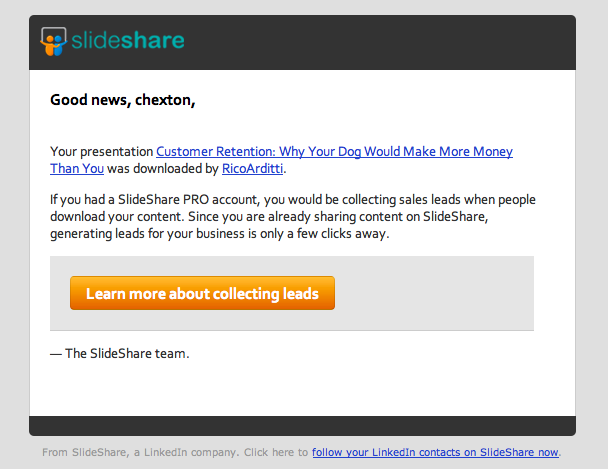
This use of automation creates a great opportunity to upsell free users as it targets customers that have just had success with Slideshare.
Similarly, they send the following email if your slides go ‘viral’ and trend on the homepage:
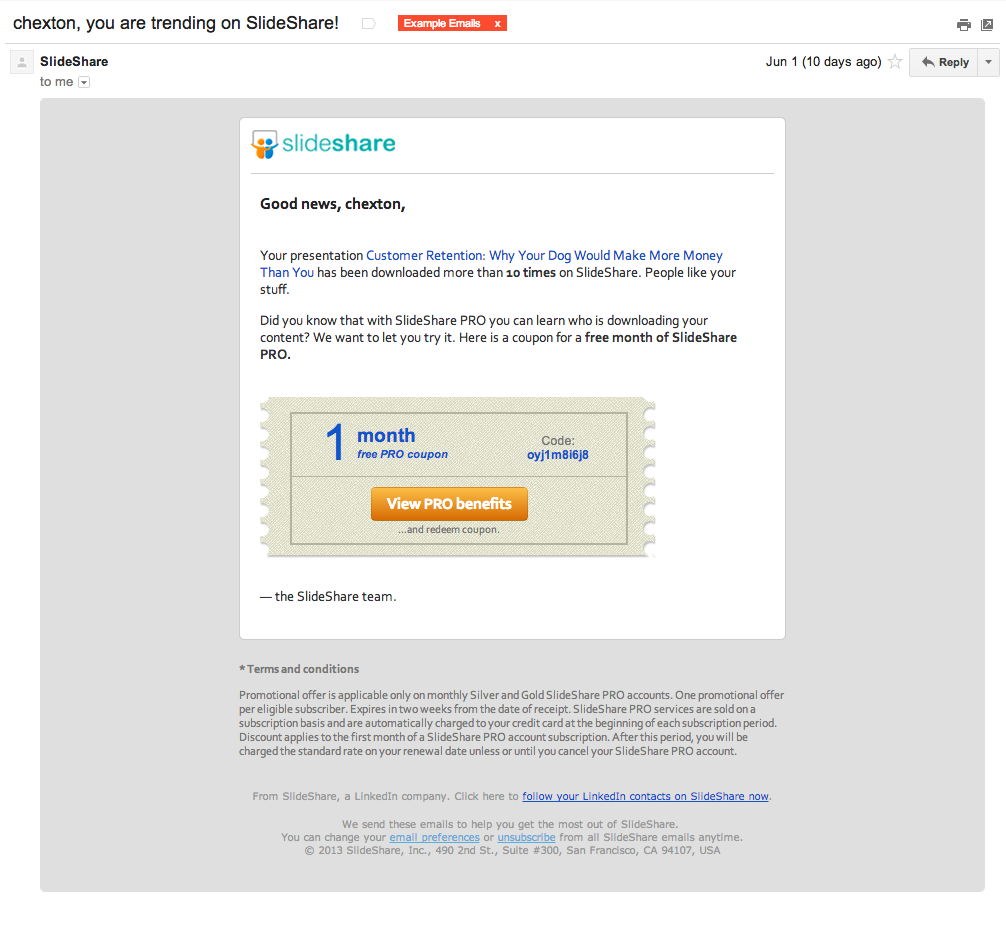
Again, the aim is to convert customers that have seen immense success with Slideshare whilst they’re on a high-note. The use of trigger-based emails is again extremely effective here.
LinkedIn use similar tactics. Their Pro accounts give you advanced features you’re likely to use a sales person or recruiter. They regularly send out targeted offers to customers that have shown intent to upgrade. Here’s an example:
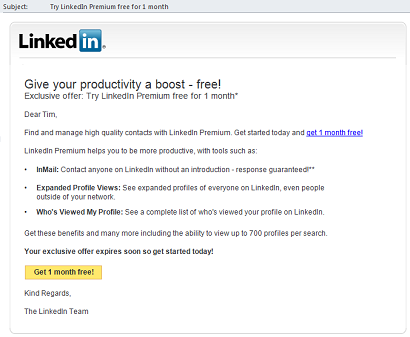
These concepts work extremely effectively for Slideshare and LinkedIn.
As they have such a large pool of potential new business and Pro customers, this tactic is a no-brainer, but the concept can be applied to your own business. The core idea is to identify activities customers take that leave them feeling positive and use those lifecycle events to trigger campaigns that very specificallyt arget them.
What can customers do when interacting with your business that you can use to convert them to paid (or more expensive) product(s)?
4. Create lock-in opportunities
37Signals has over a million users. They are certainly pioneers in their approach to online business tuning the selling of their software into a truly low-touch process. Just like Slideshare and LinkedIn, 37Signals have free features. No doubt there are many thousands of individuals using their products to tinker on a side-project or keep basic to-do lists, with no intention to upgrade.
However, these same customers may work in other organizations or on other projects for which there is value in 37Signals’ paid products. On top of the lifecycle email approach discussed above, Basecamp use announcements about their extension marketplace to drive greater retention, better product adoption and new conversions. Most of these extensions are other paid apps and most are business-focused and this strengthens the value of 37Signals’ core products and gives customers a reason to upgrade:
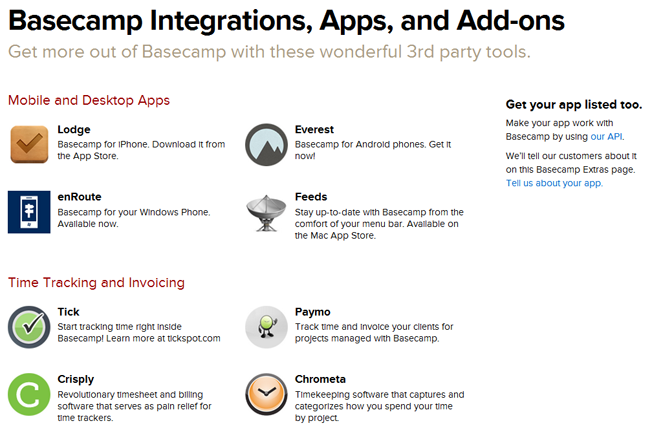
This creates a two-way flow. For example, by marketing these extensions to free users 37Signals increase the liklihood these customers will stick with the Basecamp platform for longer and, most importantly, educate these free users on the full capabilities of the product: many of which might appeal to these same users in a business context, leading them to upgrade.
The marketplace also creates increased lock-in from current business customers which leads to meaningful upgrades as they use more and more of the features and projects, much like Apple’s approach above.
Salesforce is the originator of this concept. Salesforce’s AppExchange marketplace is so powerful that many successful businesses are built simply on the back of it. It’s success has helped ensure the longevity and supreme reign of Salesforce as the world’s leading CRM. This allows Salesforce to focus on core functionality, make more money as customers stick around for longer and increase their success with ‘expansion revenue’ from up-sells and cross-sells.
Atlassian are following suite with a marketplace that is growing rapidly. Here’s an example of the regular updates Atlassian send to both small and large customers:
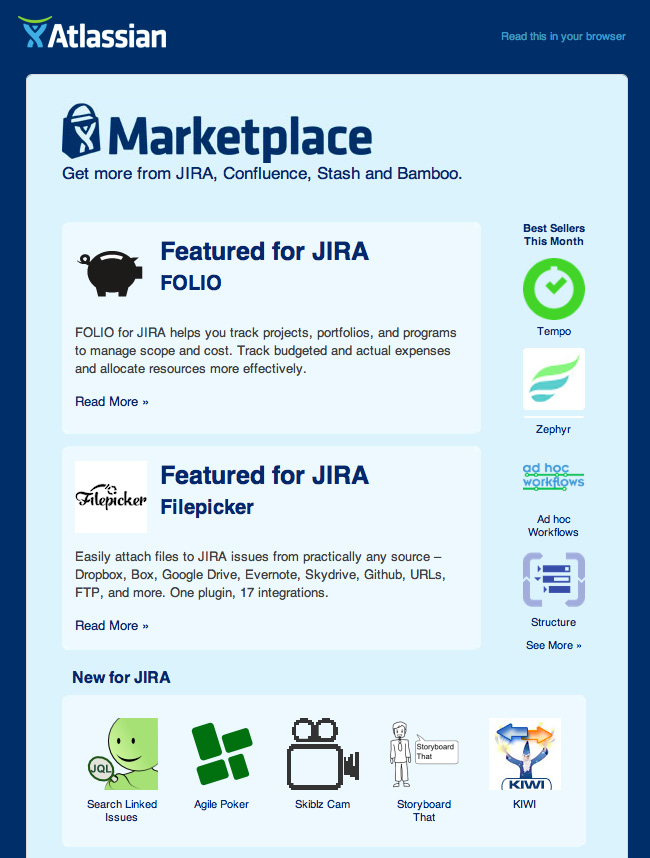
Creating this two-way growth channel is a tried-and-true strategy if you have the scale and a product that can integrate with other useful services.
How can you build a marketplace or create at least one integration or extension for your product that strengthens your customers’ relationships with your business.
Get consumer-focused users switching to business accounts, get them to stick around longer and get them to pay more!
Make more money
The ideas in this post are not new and we’ve discussed many of them before on this blog but it is extremely powerful to study the tactics in B2B scenarios and powerful to see the ideas some of the largest online software providers in the world are selling.
What other large B2B companies do have you seen embrace email marketing effectively? Let us know in the comments.
Want to start sending emails like this? Get a Vero free trial.
Want to send more personalized mobile and email messages to your users?
Learn moreCustomer story

How Vero helps Plann cater to the needs of an agile startup that's scaling up quickly

